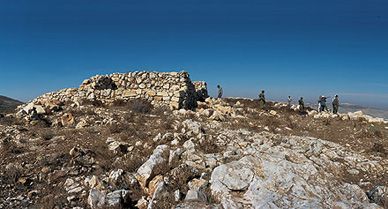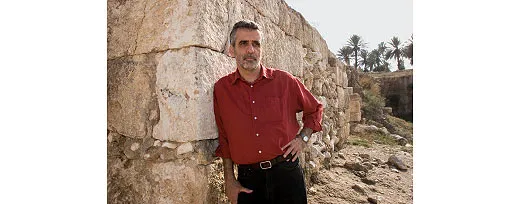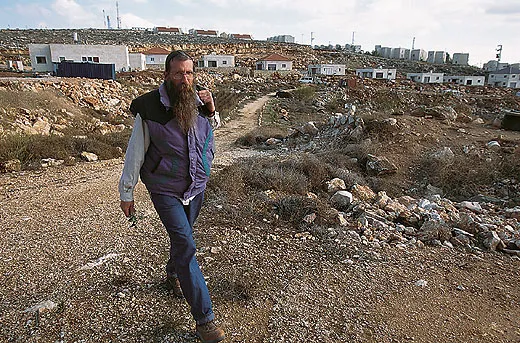Shifting Ground in the Holy Land
Archaeology is casting new light on the Old Testament
Clutching a Bible and a bag of oranges he picked at the kibbutz where he lives, Haifa University archaeologist Adam Zertal climbs into an armored van beside me. A vehicle full of soldiers is in front of us; two Israeli Army vans are behind us. The convoy sets off through the heavily guarded gates of the settlement of Karnei Shomron and onto a dusty mountain road in the Israeli-occupied West Bank. Through bulletproof windows six inches thick, we soon see the Palestinian city of Nablus in the valley below. After ten minutes the convoy stops, and an officer from the lead vehicle, an Uzi automatic weapon slung over his shoulder, runs back to consult with Zertal’s driver in Hebrew. “We are waiting for clearance for this section of the road,” Zertal tells me. “There has been trouble here in the past.”
After 20 minutes the convoy moves on. The track peters out onto a plateau, and we can see the mountains of Gerizim and Kebir on the other side of the valley. Ahead lies Zertal’s destination: a heap of stones he chanced upon in 1980 and excavated for nine years. It doesn’t look like much at first, but closer inspection reveals a rectangular structure, about 30 feet by 23 feet, with thick walls and a ramp leading up to a platform ten feet high. Zertal believes the structure was the altar that the Bible says the prophet Joshua built on Mount Ebal—the altar he built on instructions from Moses, after the Israelites had crossed into the promised land of Canaan. This, Zertal says, is where Joshua allotted the new land among the 12 tribes, and where the Israelites “became a people,” as the Old Testament puts it.
“The altar was supposed to be nonexistent, a legend,” says Zertal, leaning on crutches, a legacy of wounds he suffered in combat during the 1973 Yom Kippur War against Egypt and Syria. “At first we didn’t know what we were excavating.”
We sit on a rock, looking at the ramp and walls, and open up a Bible. The Book of Joshua describes the building of the altar, but Moses’ instructions come earlier, in Deuteronomy 27:4: “So when you have crossed over the Jordan you shall set up these stones, about which I am commanding you today, on Mount Ebal, and you shall cover them with plaster.” Meanwhile, four soldiers circle around us, guns at the ready, scouring the hillside for snipers.
Nearly every friday for the past 28 years, Zertal has gathered friends and students to map the hills and desert on the Jordan River’s west bank, seeking evidence that would illuminate how the ancient Israelites entered Canaan, or modern-day Israel and Palestine, in the late 13th century b.c. In this search, the Old Testament has quite literally been his guide. This approach was once common for archaeologists in Israel, but in recent years it has come to define an extreme position in a debate over whether the Bible should be read as historical fact or metaphorical fiction.
Those in Zertal’s camp say that all, or nearly all, the events in the early books of the Old Testament not only actually happened but are supported by material evidence on the ground. On the other side are the so-called biblical minimalists, who argue that the Old Testament is literary rather than historical—the work of ideologues who wrote it between the fifth and second centuries b.c.—and that Moses, Joshua, David and Solomon never even existed. A third group accepts the Bible as folk memory transmuted into myth—a mixture of fact and fiction. They argue over the balance between the two.
The various points of view have focused on a few fundamental questions: Did the Israelites, under Moses and then Joshua, leave Egypt, conquer Canaan and establish settlements in the 13th century b.c.? And did David and then Solomon preside over a great united kingdom, with its capital in Jerusalem and its temple on the Temple Mount, 200 years later?
In Israel, these questions reach beyond academe to the nation’s very sense of itself. In the Israeli collective consciousness, the kingdom of David and Solomon is the model for the nation-state. Under Ariel Sharon, the government invoked the Bible to support the Israeli presence in the occupied territories on the West Bank, in violation of the Fourth Geneva Convention, which prohibits civilian settlements on occupied territory. The Jewish struggle for sovereignty over all Jerusalem is also traced to biblical accounts of David’s kingdom and Solomon’s temple.
Yet most archaeologists in Israel insist their work has nothing to do with politics. Their debates, they say, focus on what is in the Bible, and what is in the ground.
For the literalists, the stones at Mount Ebal are crucial. “If this corroborates exactly what is written in that very old part of the Bible,” says Zertal, “it means that probably other parts are historically correct. The impact is tremendous.”
By 1985, Zertal had concluded that the stone structure was Joshua’s altar. It fit the Bible’s description of the site, he says, and its ramp and other features are consistent with ancient accounts of the altar at the Second Temple in Jerusalem—another example of such a structure in ancient Israel. In addition, Zertal says he found charred animal bones at the site, which he interpreted as sacrificial offerings. To Zertal, the “altar” proves that the Israelites crossed the Jordan and entered Canaan, just as the Old Testament says they did.
Zertal, 60, has a poetic affinity for the land he has spent so much time surveying. Talking to local Bedouin shepherds in Arabic about place names and checking them against biblical references, he has found what he says are more than 300 Israelite sites from the early Iron Age (or Iron Age I, as the years 1200 to 1000 b.c. are known), moving gradually westward into Israel.
But he has yet to submit his Ebal finds to radiocarbon dating. And he professes a dislike for the common archaeological practice of establishing chronologies by radiocarbon dating potsherds, or pieces of broken pottery. “Others see things through the narrow keyhole of pottery,” he tells me as I join him on one of his Friday walkabouts. “I prefer to see things in a wider perspective: history, Bible, literature, poetry.”
While Zertal’s findings on Mount Ebal have given comfort to those in Israel and elsewhere who take the Bible literally, few of his fellow archaeologists have accepted his conclusions. In an article in the Biblical Archaeology Review in 1986, Aharon Kempinski of Tel Aviv University contended that the stones were actually part of a watchtower from the first part of the Iron Age, and that there is “no basis whatever for interpreting this structure as an altar.” Most archaeologists have ignored the find. “Adam Zertal is the lone wolf,” says Uzi Dahari, deputy director of the Israel Antiquities Authority. “He’s working alone.”
“There’s definitely an Iron I site there, and there may even be evidence for cultic activity,” says Israel Finkelstein, an archaeologist at Tel Aviv University. “But I don’t think that you can take the Book of Joshua and use it as a guidebook to the architectural landscape. Joshua was put in writing much later than the events it describes and is full of ideologies related to the needs of the writers.”
Though Finkelstein occupies the middle ground between the literalists and the minimalists, he has led the challenge to traditional biblical archaeology in Israel for the past decade. He offers a markedly different picture of Israel’s early history.
Finkelstein and co-author Neil Asher Silberman rocked the world of biblical archaeology with the publication, five years ago, of The Bible Unearthed. The book argues that the biblical accounts of early Israelite history reveal more about the time they were written—the seventh century b.c.—than the events they describe, which would have taken place centuries earlier. The book also maintains that Israeli archaeologists have indulged in a kind of circular reasoning, drawing on biblical references to date a potsherd, for example, and then using it to identify places described in the Bible. The Bible, Finkelstein believes, should be used far more cautiously in interpreting archaeological sites.
Last year, Finkelstein received the $1 million Dan David Prize for innovative research, awarded by an international venture based at Tel Aviv University. But his work has proved controversial. Several archaeologists have challenged his finding that some ruins related to Solomon are too recent to fit into the biblical account of his reign (“a huge distortion,” says Amihai Mazar of the Hebrew University in Jerusalem). David Hazony, editor of a journal sponsored by a conservative Israeli think tank, wrote that “the urge to smash myths has overtaken sound judgment” in Finkelstein’s work. In an essay in the Israeli daily Ha’aretz, Hershel Shanks, editor of the Biblical Archaeology Review, likened Finkelstein to the minimalists, who, he said, were “anti-Israel” and “anti-Semitic” for their “faddish lack of pride in Israel’s history.”
Over lunch on the Tel Aviv University campus, Finkelstein, 57, jokes that his more conservative colleagues “are the guardians of the true faith. We are the simple apostates.” More seriously, he adds: “I was surprised that some scholars are completely deaf and blind, in my opinion, and they don’t accept the inevitable and very clear evidence.”
He cites the fact—now accepted by most archaeologists—that many of the cities Joshua is supposed to have sacked in the late 13th century b.c. had ceased to exist by that time. Hazor was destroyed in the middle of that century, and Ai was abandoned before 2000 b.c. Even Jericho, where Joshua is said to have brought the walls tumbling down by circling the city seven times with blaring trumpets, was destroyed in 1500 b.c. Now controlled by the Palestinian Authority, the Jericho site consists of crumbling pits and trenches that testify to a century of fruitless digging.
Finkelstein says that rather than following Joshua out of the desert into Canaan and conquering the indigenous population, the early Israelites were actually Canaanites—that is, they were the indigenous population. Yes, he acknowledges, there was a wave of new settlements on the hills to the east and west of the Jordan River around 1200 b.c. But Finkelstein says such settlements are not necessarily a sign of conquest—archaeological evidence instead suggests a waxing and waning of the population both before and after that time. Instead of marching armies and massive slaughter, he sees a slow and gradual evolution of Israelite culture. “The emergence of the different ethnic identities was a very long process,” he insists.
More and more archaeologists have accepted the idea that “the Joshua invasion as it is described in the Bible was never really a historical event,” as Amihai Mazar puts it. But they disagree about the exact nature and origins of those who built the ancient hilltop settlements on the West Bank.
Even more vexing is the question of a united kingdom under David and then Solomon. Trying to answer it has taken Finkelstein to the ruin of Megiddo, which most archaeologists once believed was the site of a palace King Solomon built sometime between 970 and 930 b.c.
An hour’s drive northeast of Tel Aviv, Megiddo is a huge archaeological tell, or mound, the result of centuries of city-building in the same confined space. The tell is complicated, featuring stone walls from 30 layers of habitation spanning six millennia. Date palms have sprouted from seeds that previous excavators spit on the ground. A magnificent view sweeps from Mount Carmel in the northwest to Nazareth to Mount Gilboa in the northeast.
Many Christians believe this will be the site of Armageddon, where, according to the New Testament’s Book of Revelation, the final battle between good and evil will be waged, followed by the second coming of Christ. Evangelical Christians regularly gather at Megiddo to pray. But the site is also the focus of the debate over whether the biblical story of Solomon can be supported archaeologically.
The second Book of Samuel declares that King David “reigned over all Israel and Judah” at Jerusalem. After David, according to the first Book of Kings, Solomon was “sovereign over all the kingdoms from the Euphrates to the land of the Philistines, even to the border of Egypt.” To many Jews, the era of David and Solomon represents their homeland’s zenith, the age of a Greater Israel. In I Kings, it is a time of great prosperity—“Judah and Israel were as numerous as the sand by the sea; they ate and drank and were happy”—during which Solomon built a great temple in Jerusalem, as well as the cities of Hazor, Gezer and Megiddo. Over the past century, four archaeological excavations have searched for Solomonic artifacts in Megiddo, concentrating in recent decades on a few stone blocks some say are the remains of a great palace and stables.
Archaeologist Yigael Yadin, who excavated Megiddo in the early 1960s, believed that the stables belonged to King Ahab, who ruled in the ninth century b.c.; a ninth-century Assyrian inscription on a stone monument at Nimrud, in modern-day Iraq, described Ahab’s great chariot force. Yadin reasoned that the palace, which lies below the stables and so must be earlier, is part of a great building from the time of Solomon. But Finkelstein, who has been excavating at Megiddo for more than ten years, argues that this chronology is wrong—that both layers are several decades later than Yadin posited.
The palace layer beneath the stables, Finkelstein notes, bears masonry marks like those found at a ninth-century b.c. palace site nearby. In addition, pottery found at the palace is almost identical to pottery found at Jezreel, about six miles away, which has also been dated to the mid-ninth century b.c. through independently dated potsherds and biblical references. Finkelstein says that Yadin’s claim, which lacks any confirmation by independent potsherd dating, rests on the I Kings reference only—“This is the account of the forced labor that King Solomon conscripted to build the house of the Lord and his own house, the Millo and the wall of Jerusalem, Hazor, Megiddo, Gezer.”
Finkelstein also says that masonry marks and potsherds from the palace layer suggest that it must have been built around 850 b.c., in the time of Ahab—who “did evil in the sight of the Lord more than all who were before him,” according to I Kings. The so-called golden age of Solomon, Finkelstein goes on, is not supported by archaeological evidence. Rather, he says, it’s a myth concocted in the seventh century b.c. by the authors of Kings and Samuel to validate Judah’s expansion into the northern territory of Israel. Finally, Finkelstein says David never united the country; rather, Judah and Israel remained neighboring states. (The only non-biblical reference to David is found in a ninth-century b.c. inscription from Tel Dan, a biblical site in northern Israel that mentions “the House of David.” Finkelstein says the inscription proves only that David existed, not that he united the kingdom.)
Finkelstein believes that pottery that the literalists date to the mid-tenth century b.c. should actually be dated to the first half of the ninth century b.c. But not everyone agrees. Hebrew University’s Mazar, one of Finkelstein’s main critics, insists with equal conviction that “it’s impossible to condense all these strata of pottery to such a short time span.”
In the fall of 2004, Mazar and Finkelstein each presented their contradictory theses at a conference at Oxford, England, and each brought in a physicist to analyze the radiocarbon dating of the objects from Megiddo. But since the margin of error for radiocarbon dating is about 50 years—within the difference between the competing chronologies—both could claim validation for their theories. The discrepancy of 50 years might seem like splitting hairs, but the implications reverberate into the present day.
Biblical archaeology has been popular in Israel since the nation’s founding in 1948. As Jews poured into Israel from all over Europe following the Holocaust, the “national hobby” helped newcomers build a sense of belonging. “There was a need to give something to the immigrants, to the melting pot,” says Finkelstein. “Something to connect them to the ground, to history, to some sort of legacy.”
In the 1950s, Yigael Yadin and his archaeological rival, Yohanan Aharoni, battled over whether the Israelites conquered Canaan by force, as described in the Book of Joshua, or whether they came peacefully, as described in the Book of Judges. In 1955, Yadin began excavating the ancient city of Hazor in the hope of finding proof of an Israelite conquest. After the Six-Day War in 1967, during which Israelis gained control of the West Bank and the Old City of Jerusalem, Israeli archaeologists began surveying those areas as well, in many cases displacing Palestinian residents to do so. The archaeologists sought out Old Testament sites and renamed places according to biblical tradition, in effect “recasting the landscape of the West Bank” in biblical terms, says Columbia University anthropologist Nadia Abu el-Haj, author of Facts on the Ground, a history of Israeli archaeology. Those terms, she says, “the [West Bank] settlers now pick up.”
Many Palestinians are understandably skeptical of any research that links biblical events to land they feel is rightfully theirs. “In Israel, biblical archaeology was used to justify illegal settlement policy,” says Hamdan Taha, director general of the Palestinian Authority’s department for antiquities and cultural heritage. “Land was confiscated in the name of God and archaeology. It’s still going on with the construction of bypass roads and the building of the separation wall inside the Palestinian land.”
In Hebron, on the West Bank, where 130,000 Palestinians live close to 6,500 Jews in the settlement of Kiryat Arba, the political implications of biblical archaeology are obvious: the tomb of Abraham, sacred to Jews and Muslims alike, has been effectively split in half since 1994, when a Jewish settler shot 29 Muslims at prayer; now, grilled windows that look out onto opposite sides of the sepulcher separate the members of the two faiths. In 2005, Ariel Sharon said the tomb justified the Israeli presence in the West Bank. “No other people has a monument like the Tomb of the Patriarchs, where Abraham and Sarah are buried,” he told the Israeli journalist Ari Shavit. “Therefore, under any agreement [on the West Bank], Jews will live in Hebron.”
However, most archaeologists who have studied the sites say there is not enough evidence to support assertions that the Hebron site is really Abraham’s tomb. Other contested sites include Joseph’s tomb in Nablus and Rachel’s tomb in Bethlehem. “It’s not real archaeology,” Finkelstein says. “It’s based on later traditions.”
More recently, a find in Jerusalem itself has stirred hope—and skepticism. Until last summer, archaeologists seeking evidence of the city David supposedly built there pointed to the few stone blocks they called the “stepped stone structure” in what is now called the City of David, south of the Temple Mount; they dated the structure to the tenth century b.c.
Last August, Israeli archaeologist Eilat Mazar (a cousin of Amihai Mazar) reported that she had found new evidence of a palace, also supposedly built by David, near the site of the stepped stone structure. Using potsherds and the traditional chronology, Mazar dated huge stones she believes made up part of the palace, to the tenth century b.c. also. The find made headlines around the world.
But detractors note that the conservative Israeli research institute sponsoring her dig, the Shalem Center, is funded by American investment banker Roger Hertog, who is on record as saying he hoped to show “that the Bible reflects Jewish history.” For her part, Mazar says her research is scientific but adds that it is “unwise to dismiss the value of the Bible as a source of history altogether.”
Finkelstein says Mazar’s stones should be dated to the ninth century, or even later. Her find, he says, only “supports what I and others have been saying for the last five years, that Jerusalem took the first step to becoming a meaningful town” a century after the time of David and Solomon.
In 1999, Ze’ev Herzog, a Tel Aviv University colleague of Finkelstein’s, convulsed the Israeli public with an article in the weekend magazine of the newspaper Ha’aretz asserting that archaeologists had shown definitively that the biblical narrative of the Israelites’ origins was not factual. Outraged letters poured into the newspaper; politicians weighed in; conferences were organized so the distressed public could quiz the archaeologists. But once the issues were addressed, feelings cooled.
Throughout most of Israel, they’re still cooling. “The idea of the Old Testament as a historical document prevails,” says sociologist Michael Feige of Ben-Gurion University, “but people don’t give it that much thought.” He adds that Israel’s shifting priorities may account for the less impassioned view. “In the 1950s, there was a collective anxiety: What are we doing here? How do we justify it? The very essence of Israeli identity depended on the biblical, historical narrative. Now, with increased fears of terrorism, the anxiety is more a personal one: What will happen to me tomorrow?” The recent election to the Palestinian leadership of Hamas, which Israel, along with the United States and the European Union, considers a terrorist organization, has hardly calmed this anxiety.
But if the general population appears less invested in a literal biblical narrative, Israel’s religious right—and particularly Israeli settlers on the West Bank—remain steadfast. “The attack on the Bible,” says Rabbi Yoel Ben-Nun, a leader in the settlers’ political movement, Gush Emunim, “is part and parcel of the general attack on Zionist values that is exemplified by the current Israeli government’s willingness, in the framework of the peace process, to hand over parts of the biblical land of Israel to the Palestinians.”
Ben-Nun and others in the settlers’ movement emphatically agree with the views of Adam Zertal and other biblical literalists. At the settlement of Elon Moreh, on a hill above Nablus, a sign quotes Jeremiah 31:5: “Again you shall plant vineyards on the mountains of Samaria.” Menachem Brody, who emigrated from Maine to Israel 28 years ago and raised a family there, runs archaeology tours supporting the literal interpretation of the Old Testament. On one such tour, passing through numerous army checkpoints in the occupied West Bank, he traced the Way of the Patriarchs, the road traveled by Abraham according to Genesis. Later, Brody stood in his own vineyard, which he planted to fulfill the Jeremiah prophecy, and said of Zertal’s discovery: “It’s the find of the century. Before, it was just a pile of stones, and it was only when we came to live here that somebody found it.”



